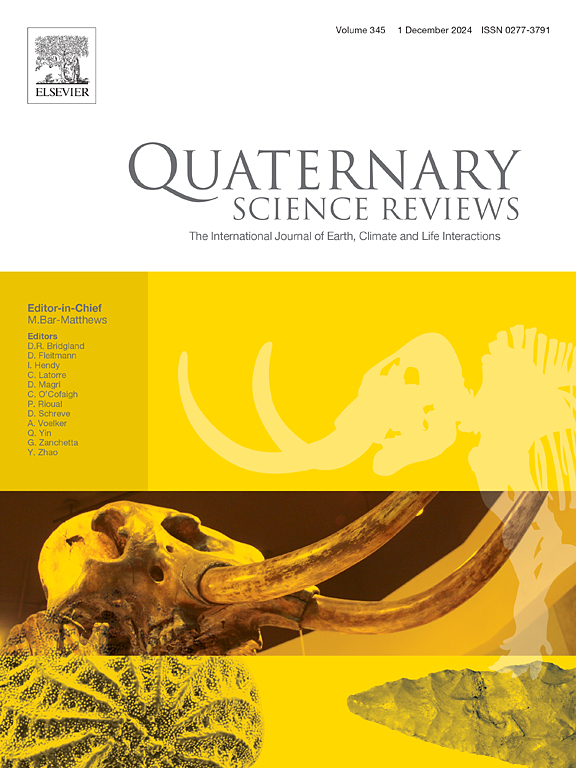Reconstruction of environmental and hydroclimate changes in the Adriatic region over the last 367 kyr from Modrič Cave (Croatia) speleothems
IF 3.2
1区 地球科学
Q1 GEOGRAPHY, PHYSICAL
引用次数: 0
Abstract
We report the longest episodic stable isotope (δ18O, δ13C) speleothem record from the eastern Adriatic coast, obtained from three U-Th dated speleothems from Modrič Cave (Croatia), covering environmental changes at orbital (glacial-interglacial cycles) and sub-orbital (millennial-to-centennial) time scales. According to the age models, speleothems grew intermittently during the last 367 ka, i.e. the time span from Marine Isotope Stage (MIS) 10 to the present, with growth episodes during 367-342 ka, 331-278 ka, 244-233 ka, 200-155 ka, 69-34 ka and from 15 ka to the present. Speleothem deposition during every interglacial and glacial period, except for the MIS 8, along with the isotope record, suggest that intermittent calcite deposition was not entirely climate controlled, but depended upon the drip site specifics, as well.
As for the speleothem isotopic signal, δ13C variations were governed by local soil bioactivity, while the δ18O signal was a proxy for regional hydroclimate processes. As commonly found in the Mediterranean, δ18O was controlled by precipitation amount, except during the three detected periods when the source effect outweighed the amount effect. Most likely, due to the weakened Atlantic Meridional Overturning Circulation (AMOC), 18O-depleted Atlantic moisture was partially compensated with 18O-enriched Mediterranean-sourced moisture. Regional teleconection between the North Atlantic region and the central Mediterranean has been characterized by a rapid response to abrupt climate system reorganization during Termination TI. Although future anthropogenic climate changes will occur under different boundary conditions, understanding the persistence of such rapid, dynamic teleconnections over longer time scales is of significant interest to the climate community.
来自克罗地亚莫德里尼奇洞穴的367年来亚得里亚海地区环境和水文气候变化的重建
本文报道了亚得里亚海东部沿海莫德里伊奇洞穴3个U-Th测年洞穴的最长幕式稳定同位素(δ18O, δ13C)记录,涵盖了轨道(冰期-间冰期旋回)和亚轨道(千年至百年)时间尺度的环境变化。根据年龄模型,在最后367 ka,即从海洋同位素阶段(MIS) 10到现在的时间跨度内,洞穴主题间歇性地生长,在367 ~ 342 ka、331 ~ 278 ka、244 ~ 233 ka、200 ~ 155 ka、69 ~ 34 ka和15 ka至今有生长期。除了MIS 8之外,每一个间冰期和冰期的洞穴沉积以及同位素记录表明,间歇性方解石沉积并不完全受气候控制,而是取决于滴注地点的具体情况。岩石层同位素信号的δ13C变化受局部土壤生物活性的控制,而δ18O信号是区域水文气候过程的代表。除源效应大于量效应的3个观测期外,地中海地区δ18O受降水量控制。最有可能的是,由于大西洋经向翻转环流(AMOC)减弱,18o -枯竭的大西洋水汽被18o -富集的地中海水汽部分补偿。北大西洋地区和地中海中部之间的区域遥相关的特征是对终止期气候系统突变重组的快速响应。尽管未来的人为气候变化将在不同的边界条件下发生,但了解这种快速、动态的遥相关在更长时间尺度上的持续性对气候界具有重要意义。
本文章由计算机程序翻译,如有差异,请以英文原文为准。
求助全文
约1分钟内获得全文
求助全文
来源期刊

Quaternary Science Reviews
地学-地球科学综合
CiteScore
7.50
自引率
15.00%
发文量
388
审稿时长
3 months
期刊介绍:
Quaternary Science Reviews caters for all aspects of Quaternary science, and includes, for example, geology, geomorphology, geography, archaeology, soil science, palaeobotany, palaeontology, palaeoclimatology and the full range of applicable dating methods. The dividing line between what constitutes the review paper and one which contains new original data is not easy to establish, so QSR also publishes papers with new data especially if these perform a review function. All the Quaternary sciences are changing rapidly and subject to re-evaluation as the pace of discovery quickens; thus the diverse but comprehensive role of Quaternary Science Reviews keeps readers abreast of the wider issues relating to new developments in the field.
 求助内容:
求助内容: 应助结果提醒方式:
应助结果提醒方式:


